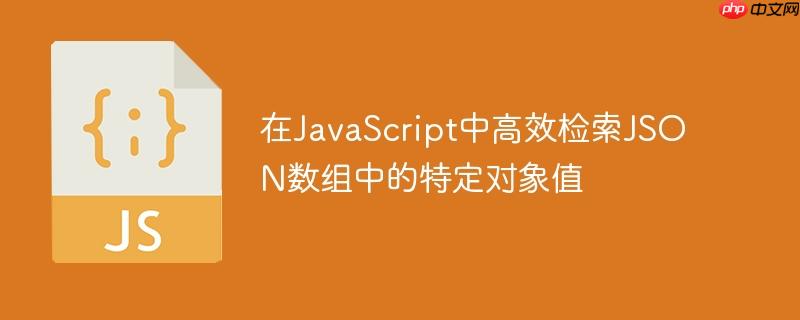
在前端开发中,我们经常会遇到以json格式表示的数据集合,其中包含多个结构相似的对象。例如,一个常见的场景是菜单或配置项列表,每个对象都包含唯一的标识符(如id)、名称(nome)、对应的url(url)等属性。
考虑以下JSON数据结构:
[
{"id":1,"nome":"smartform","url":"smartform.php","label":"Dashboard","icon":"fas fa-th-large","data_attribute":"","parent":"Smartform"},
{"id":2,"nome":"form_wizard","url":"form_wizard.php","label":"Crea uno Smartform","icon":"fas fa-plus","data_attribute":"data-action=\"create\" data-step=\"0\" data-token=\"0\"","parent":"Smartform"},
{"id":3,"nome":"fullcalendar","url":"fullcalendar.php","label":"Calendario","icon":"far fa-calendar","data_attribute":"","parent":"Tools"},
// ... 更多对象
]我们的目标是:给定一个已知的值(例如 "fullcalendar"),它对应于数组中某个对象的 nome 属性,然后找到这个对象,并提取其 url 属性的值(即 "fullcalendar.php")。
JavaScript 提供了 Array.prototype.find() 方法,它是解决此类问题的理想工具。find() 方法会遍历数组中的每个元素,直到找到一个满足所提供测试函数的元素。一旦找到,它会立即返回该元素的值(即整个对象),而不会继续遍历。如果没有任何元素通过测试,则返回 undefined。
arr.find(callback(element[, index[, array]])[, thisArg])
让我们将上述 JSON 数据转换为 JavaScript 数组,并使用 find() 方法来解决我们的问题。
立即学习“Java免费学习笔记(深入)”;
const menuItems = [
{"id":1,"nome":"smartform","url":"smartform.php","label":"Dashboard","icon":"fas fa-th-large","data_attribute":"","parent":"Smartform"},
{"id":2,"nome":"form_wizard","url":"form_wizard.php","label":"Crea uno Smartform","icon":"fas fa-plus","data_attribute":"data-action=\"create\" data-step=\"0\" data-token=\"0\"","parent":"Smartform"},
{"id":3,"nome":"fullcalendar","url":"fullcalendar.php","label":"Calendario","icon":"far fa-calendar","data_attribute":"","parent":"Tools"},
{"id":4,"nome":"gantt","url":"gantt.php","label":"Gantt","icon":"fas fa-stream","data_attribute":"","parent":"Tools"},
{"id":5,"nome":"timesheet","url":"timesheet.php","label":"Timesheet","icon":"fas fa-hourglass","data_attribute":"","parent":"Tools"},
{"id":6,"nome":"kanban","url":"kanban.php","label":"Kanban","icon":"fas fa-list-ul","data_attribute":"","parent":"Tools"},
{"id":7,"nome":"openpoints","url":"items.php?tipo=openpoints","label":"Open Points","icon":"fas fa-keyboard","data_attribute":"","parent":"Risk Management"},
{"id":8,"nome":"risks","url":"items.php?tipo=risks","label":"Rischi","icon":"fas fa-exclamation","data_attribute":"","parent":"Risk Management"},
{"id":9,"nome":"issues","url":"items.php?tipo=issues","label":"Issue","icon":"fas fa-fire","data_attribute":"","parent":"Risk Management"},
{"id":10,"nome":"changerequests","url":"items.php?tipo=changerequests","label":"Change Requests","icon":"fas fa-plus","data_attribute":"","parent":"Risk Management"}
];
const targetNome = "fullcalendar";
// 使用 find 方法查找匹配的对象
const foundItem = menuItems.find(item => item.nome === targetNome);
// 检查是否找到了对象,并提取其 url 属性
if (foundItem) {
const urlValue = foundItem.url;
console.log(`找到的 URL 是: ${urlValue}`); // 输出: 找到的 URL 是: fullcalendar.php
} else {
console.log(`未找到 nome 为 "${targetNome}" 的项目。`);
}
// 另一个例子:查找 "kanban" 对应的 URL
const anotherTargetNome = "kanban";
const anotherFoundItem = menuItems.find(item => item.nome === anotherTargetNome);
if (anotherFoundItem) {
console.log(`"kanban" 对应的 URL 是: ${anotherFoundItem.url}`); // 输出: "kanban" 对应的 URL 是: kanban.php
}在上面的代码中,menuItems.find(item => item.nome === targetNome) 这行代码是核心。它遍历 menuItems 数组,对于每个 item 对象,检查其 nome 属性是否与 targetNome 的值相等。一旦找到第一个匹配项,find() 方法就会返回该 item 对象,并将其赋值给 foundItem 变量。
正如前面提到的,如果 find() 方法没有找到任何匹配的元素,它会返回 undefined。因此,在尝试访问返回对象的属性之前,务必进行空值检查,以避免运行时错误(例如 TypeError: Cannot read properties of undefined (reading 'url'))。
const nonExistentNome = "nonexistent_item";
const result = menuItems.find(item => item.nome === nonExistentNome);
if (result) {
console.log(`找到的 URL 是: ${result.url}`);
} else {
console.error(`错误:未找到 nome 为 "${nonExistentNome}" 的项目。`);
}初学者有时可能会考虑使用 Array.prototype.filter() 来解决这个问题,因为 filter() 也能根据条件筛选数组元素。然而,find() 和 filter() 的用途和返回结果有显著区别:
对于本教程中的需求(找到一个特定对象并提取其某个属性),find() 是更高效和语义上更准确的选择,因为它在找到第一个匹配项后就会停止遍历。而 filter() 即使找到匹配项,也会继续遍历整个数组,最终返回一个包含单个元素的数组(如果只有一个匹配项),之后你还需要从这个数组中取出第一个元素。
// 使用 filter 的方式(不推荐用于此场景)
const filteredItems = menuItems.filter(item => item.nome === targetNome);
if (filteredItems.length > 0) {
const urlValue = filteredItems[0].url; // 需要从数组中取出第一个元素
console.log(`(使用 filter) 找到的 URL 是: ${urlValue}`);
} else {
console.log(`(使用 filter) 未找到 nome 为 "${targetNome}" 的项目。`);
}显然,find() 的代码更简洁、意图更明确,并且在性能上更优,因为它不需要创建新的数组,并且在找到目标后立即停止。
在 JavaScript 中,当需要从一个对象数组中,根据某个属性的值查找并提取特定对象的另一个属性值时,Array.prototype.find() 方法是最高效和最直观的解决方案。它能够精确地定位第一个匹配项,并返回该对象,避免了不必要的数组遍历和新数组的创建。始终记得在访问 find() 返回结果的属性之前进行空值检查,以确保代码的健壮性。
以上就是在JavaScript中高效检索JSON数组中的特定对象值的详细内容,更多请关注php中文网其它相关文章!

每个人都需要一台速度更快、更稳定的 PC。随着时间的推移,垃圾文件、旧注册表数据和不必要的后台进程会占用资源并降低性能。幸运的是,许多工具可以让 Windows 保持平稳运行。

Copyright 2014-2025 https://www.php.cn/ All Rights Reserved | php.cn | 湘ICP备2023035733号